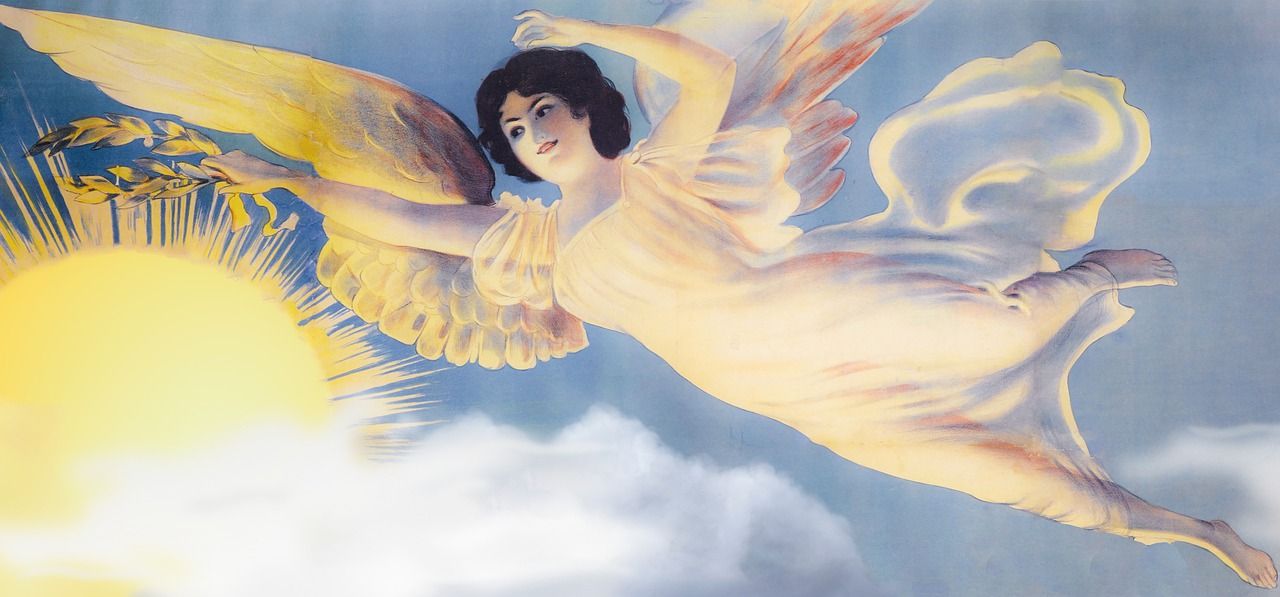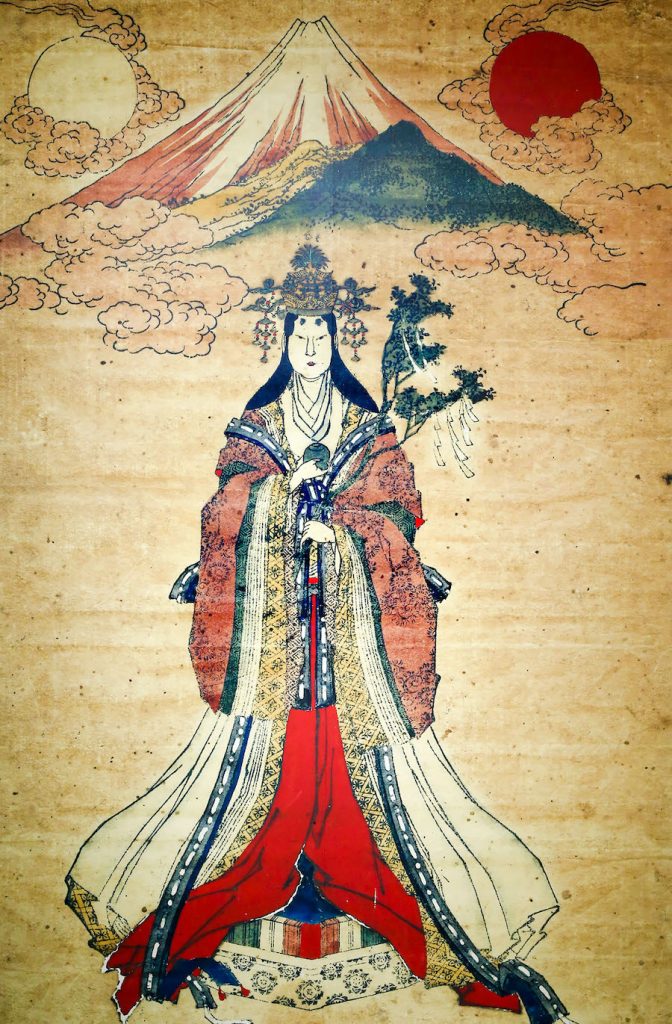
Shinto is the biggest religion in Japan that is indigenous to the Japanese people since ancient times. There are about 100,000 public Shinto shrines in Japan, There are also many, many small private shrines of that religion which people have in their homes, at times in offices, or even in their gardens. In the countries of the world that have very large numbers of Japanese, there are Shinto shrines. Shinto is Japanese for “the way of the kami”. The “kami” are sacred beings as gods, goddesses, and spirits of the forces of nature, and ancestral ghosts. During World War 2, Shinto was the state religion of Japan and once decreed the emperor to be divine. After Japan’s defeated In World War II on September 2, 1945, State Shinto was abolished by a decree of the Allied occupation forces that forbade government subsidy and support to Shinto shrines and repudiated the emperor’s divinity.
The Celestial Sun goddess Amaterasu is considered Shinto’s most important kami. She is the daughter of creator deities Izanagi (male) and Izanami (female) who created land from the waters including the 8 principal islands of Japan. Though Amaterasu did not create the universe, she, as well as other kami have created people, especially the Japanese. Note: Because of the sun being a goddess, Japan is also known as “The Land of the Rising Sun”. The flag of Japan shows a red rising sun. In some cases, the flag also shows red rays emitted from the red sun. In other cases, the flag simply shows a red rising sun over a white rectangular background.
In Shinto, there is no main “holy book” like in other religions. There is no special set of ethics taught since man is basically good and generally knows what is good and what is wrong; evil. There are no extremes taught as to what is right and wrong. Another thing about Shinto is there is no strong element of sermonize or conversion as in other religions. At all really big Shinto shrines there is a tori which is a special gateway structure which separates the sacred space of the shrine with ordinary space. Toris also identify other sacred areas, such as a mountain or a rock. Tori gateways are very often painted red because the color red is believed to ward off evil spirits.
Shinto worships and prays to the kami chiefly through its public shrines. There is no founder; no main God. Shinto does not require its adherents to follow it as their only religion. Unlike many religions, Shinto has no authority figures and is open to anyone who wishes to practice it. Funerals do not take place in Shinto shrines since death is considered impure. That reason is also why cemeteries are not built near Shinto shrines. Therefore, most Japanese have Buddhist or secular funerals, and cremation is common. Buddhism is Japan’s second biggest religion. In Japan, at the public Shinto Shrines, the laity is generally 90% priests (males) and 10% priestesses(females). Priests and priestesses are allowed to marry and have children.
 At Shinto shrines, the faithful pray for the blessings of beneficial kami and for their protection against evil, harmful, destructive kami. Shinto clergy will bless new building sites by invoking the good kami. Offerings as food and drink( traditionally rice, rice cakes, sake, salt, and/or water) are made and rituals (as incense burning, bell ringing, hands clapping, bowing, prayers, music, and dance) are performed. Many Japanese believe that beneficial kami live at the big shrines. There are special shrines in Japan devoted to the war dead. The best example is the Yasukuni Shrine, privately owed, located in the heart of Tokyo, Japan. The Meiji Emperor built the holy structure in 1886 to house the remains and souls of those who died in civil conflicts. That shrine is a burial place for over 2.5 million people who died in violence, mainly during World War 2. Shinto does not preach a heaven nor a hell for souls or spirits after death, but teaches that deceased individuals journey to the land of the dead to live there which is not far from our own land of the living.
At Shinto shrines, the faithful pray for the blessings of beneficial kami and for their protection against evil, harmful, destructive kami. Shinto clergy will bless new building sites by invoking the good kami. Offerings as food and drink( traditionally rice, rice cakes, sake, salt, and/or water) are made and rituals (as incense burning, bell ringing, hands clapping, bowing, prayers, music, and dance) are performed. Many Japanese believe that beneficial kami live at the big shrines. There are special shrines in Japan devoted to the war dead. The best example is the Yasukuni Shrine, privately owed, located in the heart of Tokyo, Japan. The Meiji Emperor built the holy structure in 1886 to house the remains and souls of those who died in civil conflicts. That shrine is a burial place for over 2.5 million people who died in violence, mainly during World War 2. Shinto does not preach a heaven nor a hell for souls or spirits after death, but teaches that deceased individuals journey to the land of the dead to live there which is not far from our own land of the living.
Unlike other religions, Shinto does not have a weekly religious service. People visit such shrines at their convenience. Some Japanese visit these shrines on special holidays of the year such as New year’s day, or Labor Thanksgiving Day or at the season’s festivals such as the snow festival or the spring festival.
At Shinto shrines, the clergy make money from selling services that deal with divination, amulets, and talismans. The same thing occurs at various Buddhist shrines, especially in Japan, Thailand, and Taiwan, China. There are random fortunes written on tiny strips of paper given out at Shinto shrines and Buddhist temples in Japan. These snippets of paper are very similar to the fortunes printed on very small papers in Chinese fortune telling cookies which are also found in various Japanese restaurants. Another form of Shinto divination is the heating of tortoise shell or the shoulder bones of a male deer(stag) and interpreting on the pattern of cracks that appear. In other cases, simply looking at the designs of certain tortoises is used for foreseeing the future.

We shall talk a bit about Buddhism. Buddhism is a religion, founded by a former prince named Siddhartha Gautama in sixth century BC India that stresses non-violence, peace, harmony, forgiveness of others, not being ruled by materialism, especially earthly; physical pleasures, spiritual meditation of the reaching of nirvana( mental bliss and enlightenment). Buddhism also teaches reincarnation, and discourages massive starvation; malnutrition; deprivation of the body. Buddhism came out of the religion of Hinduism.
There is a Buddhist form of divination, found in both Buddhist and Taoist temples, especially in China, that is often referred to as Chien Tung or Chinese fortune telling sticks by westerners. In Buddhist traditions this divination is known as “The Oracle of Kwan Yin”. The divinatory sticks are common in Thailand temples, known as Siam Si and in Japan as O-mikuji. These sticks all have numbers written on them. After asking a question about the future, the sticks are in a container which is shaken while usually pointing downward downward, a stick falls out. Multiple sticks are ignored; the practice continues until just one sticks falls out. The number on the stick matches a the number of a prophetic message that was written down previously part of a big system of numbered prophecies.
Amulets and talismans are sold at Shinto shrines and Buddhist temples. The faithful believe these charms will bring them good luck, success, and protection from harm. In some cases the name and area of the Shinto shrine or the Buddhist temple is inscribed on the charm. Little images of Buddha are very popular sellers at Buddhist temples. In Japan, there is the Hamaya, The Hamaya, literally meaning “demon breaking arrow” is a special arrow, given out for a monetary donation, at Shinto shrines and Buddhist temples as a Japanese New Year’s lucky charm or a sacred tool. Sometimes the arrow is set with a bow called a Hama-yumi.
Amulets and talismans sold at Shinto shrines and Buddhist temples come in a big variety of styles. Some are beautifully ink printed words on thick heavy paper or cloth. Others are made of metal and show imagery. There specially designed charms that are pendants; necklaces, rings, and bracelets.
In Tibet, there is a form of divination that Buddhist monks practice in their temples that deals with the interpretation of dice being thrown. This practice is called “Mo” and the Tibetan people use this system when making important decision on health, work, or travel. There books written by certain lamas on the casting of the dice.
Tibet was conquered by the Chinese armies of Mao Zedong on October 6, 1950. The Government of Tibet, under persecution pressure with great fatalities and destruction, accepted the annexation of Tibet by The People’s Republic of China under the forced; coerced signed agreement on May 23, 1951. The Dalia Lama of Tibet, the sole authority of Tibet, dressed as a Chinese soldier, fled Tibet to India on March 17, 1959, during a rare snow storm, and never acknowledged China’s territorial claim over Tibet, always insisting that Tibet is a free and sovereign; independent nation.


